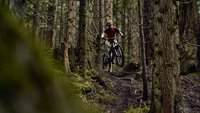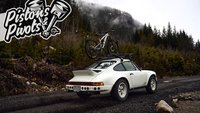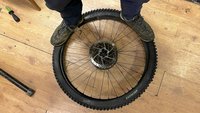
Two-Minute Reviews
Race Face Atlas Flat Pedal Review
As flat pedals go, the Race Face Atlas pedal—their top option for those that prefer to skid about with free feet—is a feature rich choice that pits itself comfortably against other pedals at this end of the market. The pedal boasts a 114mm x 101mm platform which, on paper at least, matches up with other key, large platform pedals including Deity’s T-Mac (measuring 110mm x 105mm) and OneUp’s alloy option (115mm x 105mm). Likewise the 10 pins per side, sealed bearings—four in each pedal—and low profile clearly state Race Face’s intentions.

Highlights:
- Reasonably thin platform w/ double concave profile
- Four sealed bearings per pedal and no DU bushings
- 101mm wide x 114mm long platform size
- Angled pins on forward and rear edges
- Ten bottom loaded pins/side (20 pins/pedal)
- Hidden pin with grease/access port
- Heavily chamfered edges
- Weight: 355g
- Price: 180 US
- Fully rebuildable
The Atlas pedal features a double concave profile, something that some claim to be the holy grail of flat pedals. The concave profile of the Atlas is thanks to a 14.5mm outer edge that slims into a 12mm thickness over the axle which adds up to a 2.5mm concave. On paper, it’s quite substantial, with only a select few other options providing such an aggressive cup to place your clodhoppers into. Where it may fall short for some is in relation to how this measurement is taken, with it appearing that RF do so from the tallest part of the pins to the centre, rather than the body of the pedal itself—the body shows little in the way of concave and not 2.5mm. The result? A less planted feel on the pedal than one that is a “true” 2.5mm concave. Nevertheless, it’s still a reasonably positive feeling pedal.
The Atlas pedal contains a fairly slender profile that does an excellent job of minimizing contact with obstacles while also being stout enough to can take some hits and still provide that concave. In addition to the slender shape, the chamfered edges of the Atlas pedal make sure that any contact with obstacles result in minimal energy transfer to the rider, keeping the loss of momentum at bay.

The heavily chamfered edges allow the pedal to blow off strikes and minimize energy tranfer to the rider.
The tapered shape of the pedal results in a smaller surface area to stand on, which makes the dimensions a little deceiving in reality. While the Atlas pedal provides ample traction when paired with Five Ten and Giro Jacket shoes, its listed 114mm length x 101mm width doesn’t accurately portray the physical surface area, which is closer to 105mm x 101mm. The difference is small and the measurements are still plenty large, though worth noting. Shape is, within a range, more important than all out size when it comes to pedals but the Atlas pedal could provide a more planted feel with either less taper to the platform shape or some added width, effectively providing more surface area.
With a size 10.5 US foot, coming from a squarer shaped platform like those of the OneUp alloy and Deity T-Mac mentioned, make the smaller surface area of the Atlas immediately apparent. However, the experience when coming from any other similarly shaped flat pedal, the DMR Vault, for example, is far more positive with the double concave and cleverly inboard angled pins at the front and rear edges of the pedal scooping and locking into the rubber sole of your preferred riding kicks with confidence.
Where it falls short is in very rough sections of trail, where the less positive feel underfoot results in a ride that requires a little more finesse. Smaller feet need not be concerned; get wild and when making a mess of it tripod away to your heart's content, the surface area is large enough for slightly smaller feet to get back in place, comfortably. The shape and heavily chamfered edges of the pedal will also keep you clear of trouble better than the squarer shaped options available.

Underfoot the tapered shape of the Atlas pedal results in smaller feeling pedal than others that feature a square shape.

With a size 10.5 US Five Ten, the Atlas pedal doesn't fully support the outermost portion of the foot.
The Atlas pedal is rebuildable, with Race Face offering aftermarket kits which, for about 49.99 US, will keep the pedals running for years to come. Pedal wear is inevitable, but don’t think that the kit is to make up for a poorly designed product; the Atlas pedal will take a hiding and stand the test of time before needing its innards replaced. With an initial price of 180 US, the Atlas are clearly a top shelf selection and they stack up well with the competition in terms of features/price. The option to rebuild helps the pedal go that bit further, with the kit providing everything aside from the platform and a full set of pins; new axles, bearings, seals and some spare pins, all covered.

Lots of colour choice—six options total including the blue anodized version tested.
For more on Race Face's Atlas pedals, click here...







Comments
RNAYEL
6 years, 4 months ago
I have size 13 feet and I'm running these pedals on both of my mountain bikes for the past two years. I"ve picked up a rebuild kit but haven't had to use it yet. Very happy with the performance and support.
(I use them as winter pedals, switching to clipless for summer riding)
Reply
Tehllama42
6 years, 4 months ago
I never thought I'd bother with expensive pedals. I got a set of these with a used bike, and at this point, unless I'm trying to hit a price point under $2000, I won't run anything less.
Size 12 feet, the double-concave works really well with my excessively budget shoes (Harsh Arabica), though I can only get a season out of those $10 beauties.
For anybody silly enough to count grams on a bike with flat pedals, these definitely meet the $1/g criteria if you're willing to shop aggressively. Curiously, they seldom show up used anywhere.
Reply
AJ Barlas
6 years, 4 months ago
Have either of you tried many bigger, squarer platforms? You have big feet and I feel are prime to benefit from the support. These are definitely long lasting pedals so it's good to see others getting a lot of time out of them. Not many being available used is great testament to their performance, huh.
Reply
RNAYEL
6 years, 4 months ago
These are the biggest platforms that I've ridden, my previous flat pedals had been Shimano MX80 and Kona WahWah/Nukeproof Neutron (same design, different sticker) - had both, liked them - those were 98mm (w) x 99mm x 17mm. Otherwise I'm in clipless pedals, I've been running time pedals with much success since 2008. Just picked up a set of DMR V-Twin to throw on the Spec. Enduro in the spring.
Reply
whatyouthink
6 years, 4 months ago
I have size 13 feet and ride vp harriers (as well as the azonic rebrand of the harrier) and they are great. I also rock a rather stiff freerider elc (one of the few flat shoes with a lace cover). the combo really eases foot pain i have experienced on smaller pedals.
Reply
Shrockie
6 years, 4 months ago
I have these and they're very good. I think my next set will be OneUp for slightly larger platform.. I tend to ride with my feet outboard a little and they move around a bit in rough sections like AJ alluded to.
Reply
AJ Barlas
6 years, 4 months ago
You'll be very happy with the OneUp, Shrockie, especially with liking to run your foot a little further from the crank arm.
Reply
Andeh
6 years, 4 months ago
I've been riding these pedals for a couple years now. I've noticed the same thing that with size 10 FiveTens, my feet tend to end up a little off the side of the pedals. I have the nylon OneUp pedals on my second bike, and their usable platform feels bigger in comparison. I'd also add that the stock bearings (and those included in the service kit) are not very durable. I was replacing them about twice a year, following very moderate use (couple rides per week) in generally dry conditions. However, since I replaced the stock bearings with Enduro MAX bearings, the wear stopped, at a cost of a bit more bearing resistance (the pedals don't free spin). Otherwise, they're good pedals: lightweight, very durable, and good grip.
Reply
Skooks
6 years, 4 months ago
I have been running these pedals for 6 months and really like them. The only drawback I have found is that they are almost too grippy sometimes. Easily solved by removing a few pins but I haven't bothered. I am curious about the grease Port though. I took the end cap off, and the grease port just seems to connect to the hole bored through the length of the axle. Any grease you inject would end up coming out of the crank end of the axle. How would this work for getting grease into the bearings?
Reply
Please log in to leave a comment.